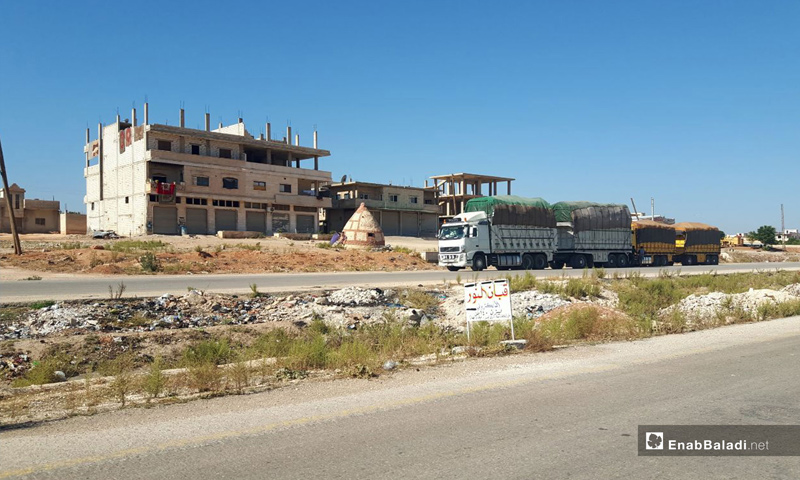In the opposition-controlled Idlib governorate, Northern Syria, there are four gateways leading to the Syrian regime-controlled areas, located in the southern, eastern and western parts of it, in addition to the Bab al-Hawa Border Crossing, open to the Turkish side and the largest of the Syrian border crossings.
The “Hay’at Tahrir al-Sham” (HTS) seized Bab al-Hawa crossing in 2017 following the confrontations it had against the “Harakat Ahrar al-Sham al-Islamiyya” and said that it handed it over to “an unaffiliated civic administration.”
“The civic administration is an associate of Idlib’s Administration, which follows HTS […] and to which all the revenues go undercover of civil foundations,” a source, informed of the Bab al-Hawa crossing’s affairs, said.
In the past a few months, all the crossings were operated for commercial or humanitarian ends, except for the Murak crossing, northern rural Hama, closed down by the regime late in 2018 without an explanation.
The way how the crossings are controlled and run differed in parallel with the military factions operating in the governorate. “Tahrir al-Sham” controlled the Murak and al-Eiss crossings, in addition to Bab al-Hawa, while the Qalaat al-Madiq remained under the management of “Ahrara al-Sham,” rallied around the “National Front for Liberation.”
“Nour al-Din al-Zenki Movement” managed the al-Mansurah crossing, functioning as a link with the regime-held areas in western rural Aleppo. This crossing’s management shifted to “Tahrir al-Sham” after it expanded its presence in the western rural parts of Aleppo through the confrontations the area witnessed in the past a few days.
“Salvation Government” Acts
With the beginning of 2019 and less than a month from the Cabinet reshuffle made by the founding committee of the “Salvation Government,” downswing the number of ministries from 11 to nine, the latter took a number of steps to coordinate the crossings’ operation process, seeking full control of them.
Mohammad al-Ahmad, the Minister of Economy, said that the crossings in Idlib are of two types; the first type is assigned for trade and humanitarian functions, such as the Bab al-Hawa border crossing, and the second is for pure commercial functions.
The commercial traffic is achieved in coordination with the “General Directorate of Customs,” an entity under the “Salvation Government,” while the people’s movements are coordinated with the “General Directorate of Migration” of the “Ministry of Interior,” al-Ahmad told Enab Baladi.
According to al-Ahmad, the crossings’ revenues are invested in services, particularly the renovation of international roads, and the Cargo Transportation Office, which provides shipping goods to/from the neighboring areas, in addition to protection, while there are not accurate statistics about the size of revenues generated by the crossings.
The “Syrian Salvation Government” was founded in November 2017; it imposed itself on the area and started to assume the its administrative and service responsibilities, which raised a number of questions about the future of the area, especially that there is another government there, the “Syrian Interim government.”
The “Salvation Government” is accused of being a façade for the “Tahrir al-Sham” in control of the area’s joints, while others consider it a “necessity for saving Idlib” in the shadow of the many complexities it is enduring.
What Lies Ahead of the Crossings?
The action taken by the “Salvation government” in operating the crossings correspond to “Sochi” deal, signed in September 2018, providing for the foundation of a buffer zone between the opposition-held areas and the Syrian regime-held areas and the reopening of the international highways passing through Idlib, Damascus-Aleppo and Latakia-Aleppo.
To the day, the mechanisms with which the second term, the reopening of the international highways, would be achieved has not been made clear. Similarly, the fate of the crossings on Idlib’s borders from the Syrian regime’s side has not been defined.
The crossing’s future is related to that of the whole area, according to al-Ahmad, who pointed out that the al-Eiss crossing, southern rural Aleppo, is yet active, unlike the Murak crossing, which the “Salvation Government” seeks to reopen, “as to alleviate some of the merchants’ burdens and change the commodities’ prices for the sake of the citizens.”
In November 2018, the “Salvation Government” issued a statement in which it said that the reopening of the Murak crossing “is to mitigate the suffering of our people in the liberated areas and a continuation of the around the clock security and military efforts.”
“The crossing is reopened as to revive the economic movement and scale it up in the liberated areas,” the government added, pointing to “the efforts done by the Economic Office in rural Hama to reopen the crossing.”
Concerning al-Eiss crossing, located in southern rural Aleppo, between the two areas of al-Eiss and al-Hader, people from the area told Enab Baladi that the trade traffic is ongoing, and pointed that “vehicles loaded with commodities enter from the Syrian regime-held areas to those held by the opposition every two days.”

